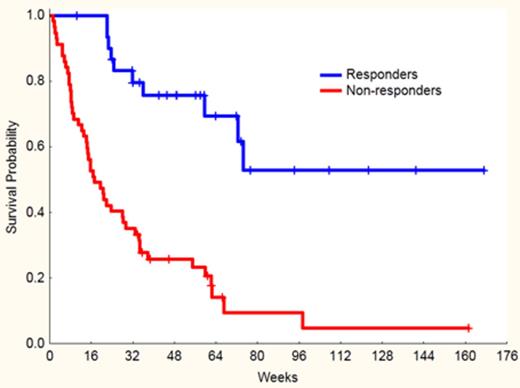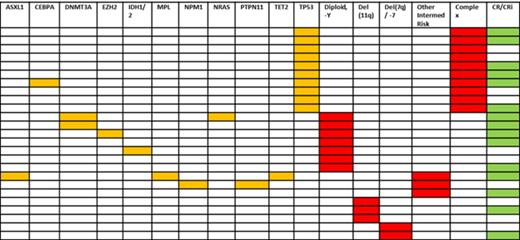Abstract

Hypomethylating agents (HMAs) are currently the front-line therapeutic choice for patients with higher risk MDS, and also frequently employed in elderly AML or in AML patients not otherwise eligible for standard intensive therapy. A number of combination strategies are under development to improve the results of HMA monotherapy. Given the single-agent activity of both azacitidine (AZA) and lenalidomide (LEN) in patients with MDS and AML, a scientific rationale exists to explore this therapeutic combination strategy. Previous studies have evaluated the combination of AZA and lenalidomide in this population with encouraging results, using lenalidomide at doses ranging from 5 to 50mg daily over 5 to 28 days per cycle. The optimal dose and schedule for this combination remains unknown.
We report our completed Phase I/II study of sequential AZA and lenalidomide in 88 patients with high-risk MDS and AML. Phase I eligibility included relapsed/refractory AML or MDS patients with bone marrow blasts >10%. Phase II eligibility included untreated high-risk MDS, or AML with 20-30% blasts. All subjects were registered into the RevAssist® program. Median age was 67 (range 32–88). Per WHO criteria, there were 42 MDS patients (48%), 3 (3%) with CMML-2, 20 (23%) with RAEB-T (i.e. 20-30% bone marrow blasts), and 23 patients (26%) with AML (>30% blasts). All subjects received 75mg/m²/day AZA days 1-5 of each 28-day cycle. LEN was administered orally for 5 or 10 days, starting on day 6 per cycle. 28 patients in the Phase I and 60 in the Phase II portion were treated. In the Phase I portion, 7 levels of LEN were evaluated with the following doses and schedules: 10mg x 5 days (n=5), 15mg x 5 days (n=3), 20mg x 5 days (n=3), 25mg x 5 days (n=3), 50mg x 5 days (n=4), 75mg x 5 days (n=3), and 75mg x 10 days (n=7). The initial Phase II starting dose was LEN 50mg daily x 10 days, however due to myelosuppression and infections with repeated cycles in the first 20 Phase II subjects, the Phase II dose was amended to LEN 25mg daily x 5 days, and another 40 patients were evaluated.
In the entire cohort, overall response rate (ORR) was 35% (31/88) (15 CR; 16 CR with incomplete count recovery (CRi)), with median overall survival (OS) of 33 weeks (range 1-172). Phase I ORR was 14% (4/28) and Phase II ORR was 45% (27/60). Of the 40 patients receiving the optimal Phase II dose, ORR was 55% (22/40), with 75 week median OS. In responding patients (n=31), the median response duration was 29 weeks (range 2 - 127 weeks), with a median overall survival that has not been reached with a median follow-up time of 57 weeks (Figure 1). 13 of the 31 responding patients (42%) proceeded with stem cell transplant, of which 10 patients continue in a sustained remission. In a cohort of 25 molecularly annotated patients (Table 1), 5 of 9 (56%) TP53-mutant patients, all with complex cytogenetics, achieved CR/CRi. By multivariate analysis, treatment was associated with worse OS in patients with bone marrow blasts > 30% (HR 4.5, 95% CI 2.4 – 8.5, p < 0.001), complex cytogenetics (HR 3.4, 95% CI 1.8 – 6.2, p < 0.001), and lenalidomide dose (HR 2.2, 95% CI 1.1-4.4, p = 0.03).
In conclusion, we identify the combination of AZA 75mg/m²/day on days 1-5 with 25mg LEN on days 6-10 over a 28-day cycle as an effective front-line regimen for high-risk MDS and AML with up to 30% blasts. Responses are rapid with a median of 2 cycles for response, durable, and treatment with this dosing schedule is well tolerated.
Somatic mutations, cytogenetics and response in the annotated subset of 25 patients
Somatic mutations, cytogenetics and response in the annotated subset of 25 patients
Garcia-Manero:Celgene: Research Funding.
Author notes
Asterisk with author names denotes non-ASH members.

This icon denotes a clinically relevant abstract



This feature is available to Subscribers Only
Sign In or Create an Account Close Modal